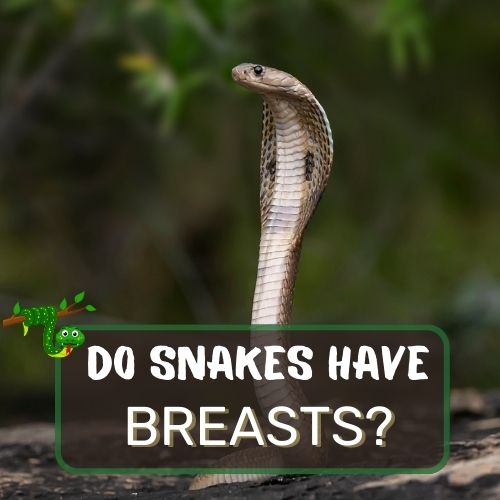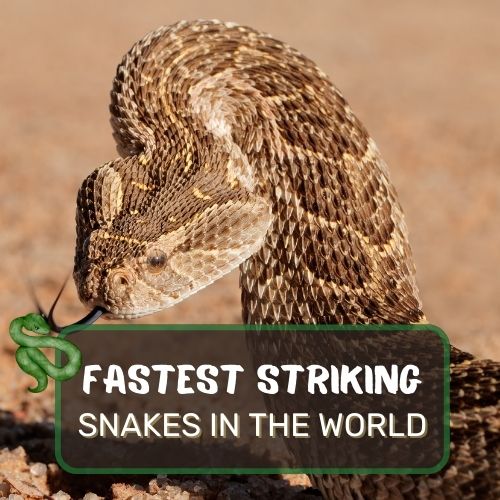
In this article, we will explore the intriguing question, “Do snakes have breasts?”
We will delve into the unique anatomy and reproductive strategies of snakes, discussing the absence of mammary glands and milk production.
Discover the fascinating world of snakes as we debunk common misconceptions, compare their parenting behaviors with other reptiles, and provide clarity on this curious topic.
Unravel the truth behind the myth and gain a deeper understanding of these remarkable reptiles.
Join us on this captivating journey through the diverse wonders of the animal kingdom.
Table of Contents
Do Snakes Have Breasts? Short Answer
No, snakes do not have breasts. Unlike mammals, snakes lack mammary glands and, therefore, do not produce milk to feed their offspring. Instead, snake hatchlings are independent from birth and rely on their instincts and hunting abilities to find food and survive. The absence of mammary glands is a significant difference between snakes and mammals in their reproductive and nurturing strategies.
Anatomy of Snakes

The Physical Features of Snakes
Snakes are fascinating creatures with a unique anatomy that sets them apart from mammals. Their long, cylindrical bodies covered in scales enable them to slither and maneuver effortlessly through various terrains, making them skilled hunters in their environments.
Their Reproductive System
Snakes have their own distinct methods of reproduction. Most snakes are oviparous, meaning they lay eggs. After fertilization, the female will lay a clutch of eggs, which she will then incubate or leave to hatch on their own, depending on the species.
However, some snake species are viviparous, giving birth to live young instead of laying eggs.
Absence of Mammary Glands and Nipples
An interesting fact about snakes is that they lack mammary glands and nipples, unlike mammals. As a result, they do not produce milk to feed their offspring.
Instead, snake hatchlings are left to fend for themselves from the moment they emerge from their eggs or are born. Nature has equipped them with instincts and skills to survive in their habitats right from the start.
Mammalian Breasts and Milk Production

The Purpose and Function of Mammalian Breasts
Mammals, including humans, have a completely different approach to nurturing their young. Breasts in mammals serve as specialized glands that produce milk.
The primary purpose of this milk is to provide essential nutrients, antibodies, and growth factors to the newborns. It is a remarkable adaptation that has evolved over millions of years to ensure the survival of the species.
Milk Production and Nursing in Mammals
Milk production, or lactation, begins after the birth of the offspring. Hormones trigger the mammary glands to start producing milk, tailored perfectly to the specific needs of the newborn.
The mother then nurses her young by allowing them to suckle on her nipples, delivering the much-needed nourishment.
This nurturing and intimate bond between mother and offspring creates not only a physical connection but also an emotional one.
Nursing not only provides sustenance but also offers comfort and security to the young, strengthening the maternal-infant bond.
Reptiles and Milk Production

The Absence of Milk Production in Reptiles
Reptiles, including snakes, have their own unique evolutionary path when it comes to reproduction and nurturing their offspring. Unlike mammals, reptiles do not possess mammary glands, and as a result, they do not produce milk.
This absence of milk production is a significant difference between mammals and reptiles and reflects the diverse strategies these two groups have adopted to ensure the survival of their young.
Differences in Reproductive Strategies between Mammals and Reptiles
The reproductive strategies of mammals and reptiles highlight the remarkable adaptations that have evolved to suit their respective environments. Mammals are viviparous or oviparous, giving birth to live young or laying eggs, respectively.
The nurturing nature of mammals involves feeding their young with milk produced by specialized mammary glands.
On the other hand, reptiles, including snakes, have opted for a more independent approach, with some laying eggs and others giving birth to live young, but without the involvement of mammary glands and milk production.
Snakes and Reproduction

Snake Reproduction Methods (Oviparity and Viviparity)
Snakes exhibit a diverse range of reproductive methods, with different species employing either oviparity or viviparity. Oviparous snakes lay eggs, and these eggs are deposited in a suitable location where the mother provides little to no parental care.
She may protect the eggs until they hatch, but once they do, the hatchlings are left to fend for themselves.
Viviparous snakes, on the other hand, give birth to live young. This method of reproduction involves the embryo developing within the mother’s body, where it receives nourishment through a placenta-like structure.
Once fully developed, the mother gives birth to live offspring, providing them with a head start in life.
How Snakes Nourish Their Young Without Milk
Snakes have developed alternative ways to nourish their young without relying on milk. Oviparous snake hatchlings, upon hatching, are born with a yolk sac, which contains essential nutrients to sustain them during the early stages of life.
This yolk provides enough nourishment for the hatchlings to survive until they can hunt and feed independently.
For viviparous snakes, the embryos receive nourishment from a placenta-like connection to the mother, similar to how mammalian fetuses are nourished during gestation.
This placenta-like structure facilitates the exchange of nutrients and waste between the mother and the developing embryos, ensuring their proper growth and development.
The remarkable diversity in reproductive strategies among snakes showcases the adaptability and ingenuity of nature, with each species finely tuned to its ecological niche.
While snakes may not have mammary glands or produce milk, their offspring are well-equipped to navigate their environment and continue the circle of life.
Comparison with Other Reptiles

How Other Reptiles Care for Their Young
While snakes take a more hands-off approach when it comes to parental care, other reptiles exhibit diverse behaviors in nurturing their offspring. Crocodilians, for example, are known for their maternal instincts.
Female crocodilians construct nests and carefully tend to their eggs, providing protection and occasionally helping the hatchlings to emerge.
Once hatched, the mother remains vigilant, guarding her young and ensuring their safety until they are capable of fending for themselves.
Similarly, some species of turtles display nurturing behavior. Female turtles often dig nests to lay their eggs, and they may actively shield the nests or hatchlings from predators.
Additionally, some turtle species exhibit temperature-dependent sex determination, where the temperature during incubation determines the sex of the offspring—a fascinating aspect of reptilian reproduction.
The Absence of Nursing Behaviors in Snakes
Snakes, in contrast, lack these parental care behaviors. They do not exhibit the nurturing tendencies seen in crocodilians and turtles. Instead, their reproductive strategy emphasizes self-sufficiency.
Snake hatchlings emerge from eggs or are born with instincts and physical attributes that allow them to immediately begin seeking food and shelter without any maternal guidance.
Common Misconceptions
Some people might mistake certain anatomical features of snakes as breasts due to their position along the snake’s body.
These features are called “ventral scales” or “subcaudal scales” and run along the underside of the snake. Ventral scales play a crucial role in helping snakes move, providing traction and stability during slithering.
The confusion may arise from their resemblance to the mammary glands found in mammals, but it is essential to remember that these scales have no connection to reproduction or nursing.
They are an integral part of the snake’s body structure, assisting in locomotion and distinguishing different snake species based on scale patterns.
By dispelling these misconceptions, we gain a better understanding of the unique characteristics and adaptations of snakes and other reptiles.
Appreciating the diversity of reproductive strategies and parental care behaviors among different animal groups enriches our knowledge of the natural world and the wonders of evolution.
Historical and Cultural References
Historically, snakes have been subjects of numerous myths, legends, and folklore. One of the more curious and less common myths is the idea of snakes nursing their young or possessing breasts. For instance:
- Ancient Egypt: The goddess Isis, often depicted with wings or as a bird, sometimes took on the form of a snake. In some tales, she’s shown nursing her son Horus in serpent form.
- Medieval Bestiaries: These illustrated books, detailing both real and mythical creatures, occasionally depicted snakes with mammalian features, including breasts, drawing from biblical or classical sources.
- Greek Mythology: Cecrops I, the mythical first king of Athens, was often described as having a serpent’s tail below the waist and was sometimes associated with nursing imagery.
However, it’s essential to note that these tales are purely symbolic or allegorical. In reality, snakes are reptiles and do not nurse their young or possess mammary glands. The myths likely arose from attempts to explain natural phenomena or convey cultural beliefs and values.
FAQ
Do Snakes Breastfeed?
No, snakes do not breastfeed. Unlike mammals, snakes lack mammary glands and do not produce milk to nourish their offspring. Snake hatchlings are independent from birth and rely on instinct and hunting skills to find food and survive.
Can Snakes Tell Gender?
Snakes do not possess external genitalia, which makes it challenging to determine their gender at a glance. However, experienced herpetologists and veterinarians can often identify the sex of snakes through internal examination or by observing specific characteristics such as size, tail shape, or the presence of spurs in some species.
How Do You Tell if a Snake is a Female?
Determining the sex of a snake requires closer examination. Female snakes may have slightly broader bodies to accommodate eggs during the reproductive season, but this distinction may not always be apparent. In some cases, probing or imaging techniques are used by experts to determine the sex of snakes more accurately.
How Long Are Snakes Pregnant?
Snakes, as ectothermic animals, do not undergo a traditional pregnancy like mammals. The gestation period varies depending on the species. For oviparous snakes (laying eggs), the incubation period can range from several weeks to a few months, while viviparous species (giving birth to live young) carry their offspring for a similar duration before giving birth.
Understanding the biological realities and unique characteristics of snakes helps dispel misconceptions and fosters a deeper appreciation for these remarkable reptiles. As we continue to learn more about these creatures, we unveil the wonders of the natural world and the diversity of life that surrounds us.
Conclusion
Throughout this article, we delved into the fascinating world of snakes, exploring their anatomy, reproductive strategies, and nurturing behaviors.
We discovered that while snakes and mammals both have unique approaches to reproduction, snakes do not have mammary glands and, therefore, do not produce milk to feed their young.
We clarified common misconceptions about snakes having breasts or nursing abilities, shedding light on the biological realities of these magnificent reptiles.
Let us reiterate that snakes are not capable of breastfeeding or nurturing their offspring through milk production. Embracing accurate knowledge about snakes deepens our understanding and respect for the diverse wonders of the animal kingdom.




0 Comments